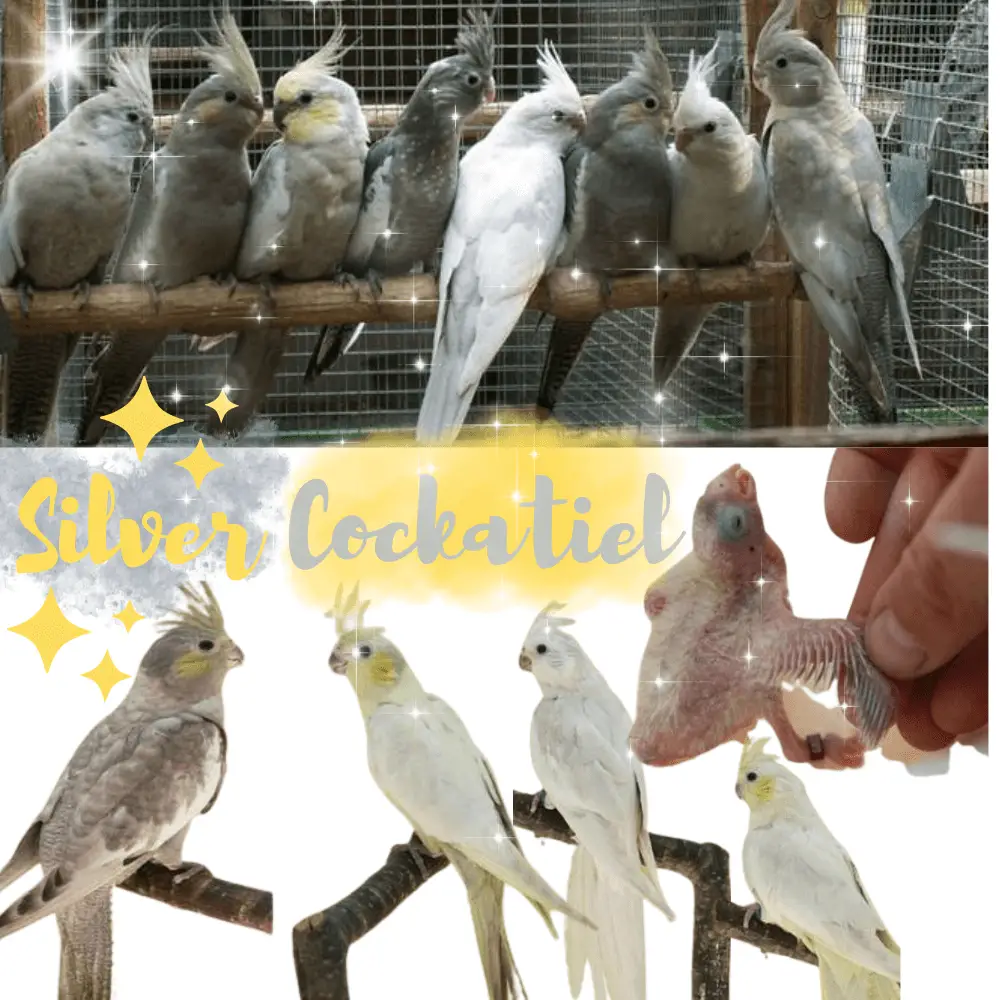
The dominant edged mutation in the Common cockatiel pet Parakeet Other names: Silver Cockatiel or DOMINANT SILVER, BLACK HEAD This mutation, first of all, appeared in Scotland in the 80s. It arrived on the continent by French breeders who imported it in the 90s. She was called SILVER-DOMINANT then TETE-NOIRE. Currently, we see appear the name DOMINANT PASTEL.
The most appropriate name is EDGED. That English term could be translated as “BORDURED”. It represents well the appearance of the pen after the action of the mutation, an aspect which gives an Impression of darkness at the edge of the feather. Indeed, there is a change in the distribution of melanin on the feathers of the body and wings but NOT ON THE HEAD (hence the name BLACK HEAD). The amendment consists of a clarification of melanin in the center of the feathers due to a repression of melanin to the outside of the feathers.
It should be noted that there are VERY DARK mutants and other VERY CLEAR mutants. I was able to observe in my matings with this mutation that light birds can give regardless of light or dark birds, as well as a dark parrot, give the same results. In fact, dark subjects are simply mutant subjects in whom the expression of the mutation is very little marked (LIMITED PENETRANCE).
In dark subjects, from the nest, one must to recognize mutants, look for the border at the neck which separates the darker head (even slightly) and the neck a little lighter. From even an observation of PRIMARY TECTRICES undoubtedly allows identify EDGEDs with certainty. Indeed the characteristic design allows you to be 100% certain of the color of a mutant.
Note that females are in general much darker than males.
Silver Cockatiel mutation
Heredity: This mutation is AUTOSOMAL CO-DOMINANT which means that we NEVER have porters and that there are SIMPLE FCATORS and differentiable DOUBLE FCATORs.
sf = SINGLE FACTOR df = DOUBLE FACTOR
EDGED sf x NON EDGED gives:
- 50% EDGED sf
- 50% NON-EDGED
EDGED sf x EDGED sf gives:
- 25% EDGED df
- 50% EDGED sf
- 25% NON-EDGED
EDGED df x NO gives:
- 100% EDGED sf
EDGED df x EDGED sf gives:
- 50% EDGED df
- 50% EDGED sf
Combinations: Most colors can be combined with this mutation but the BEST COMBINATIONS REMAIN IN GREY SERIES with the WHITE FACE, YELLOW CHEEKS, or PALE FACE.
Some time ago I said that the combination with the INO was of no interest because the INO EDGED had to be the Same as INO NON-EDGED. Well, I was wrong, because at the cockatiel INO (LUTINO, ALBINO, CREME-INO), a mutation that does not remove all melanin since a clear suffusion exists in males, we found that INO-EDGED has Light marks of melanins on feathers, tectrices, and caudals.
I started working EDGED with OPLINE (PEARL) and CINNAMON. The latter combination gives a light beige bird with a slightly darker brown head. I hope get this color now with the YELLOW CHEEKS (CINNAMON EDGED YELLOW CHEEKS).
Like the PALE FACE, the EDGED is One of the changes that has revived interest in cockatiel in the world of breeding but this interest will only be maintained if we work the birds These birds by taking care of the type and size and not content with produce mutants.
Silver Cockatiel In the nest, at Three weeks, we already observe at the neck a line of contrast that characterizes EDGED.
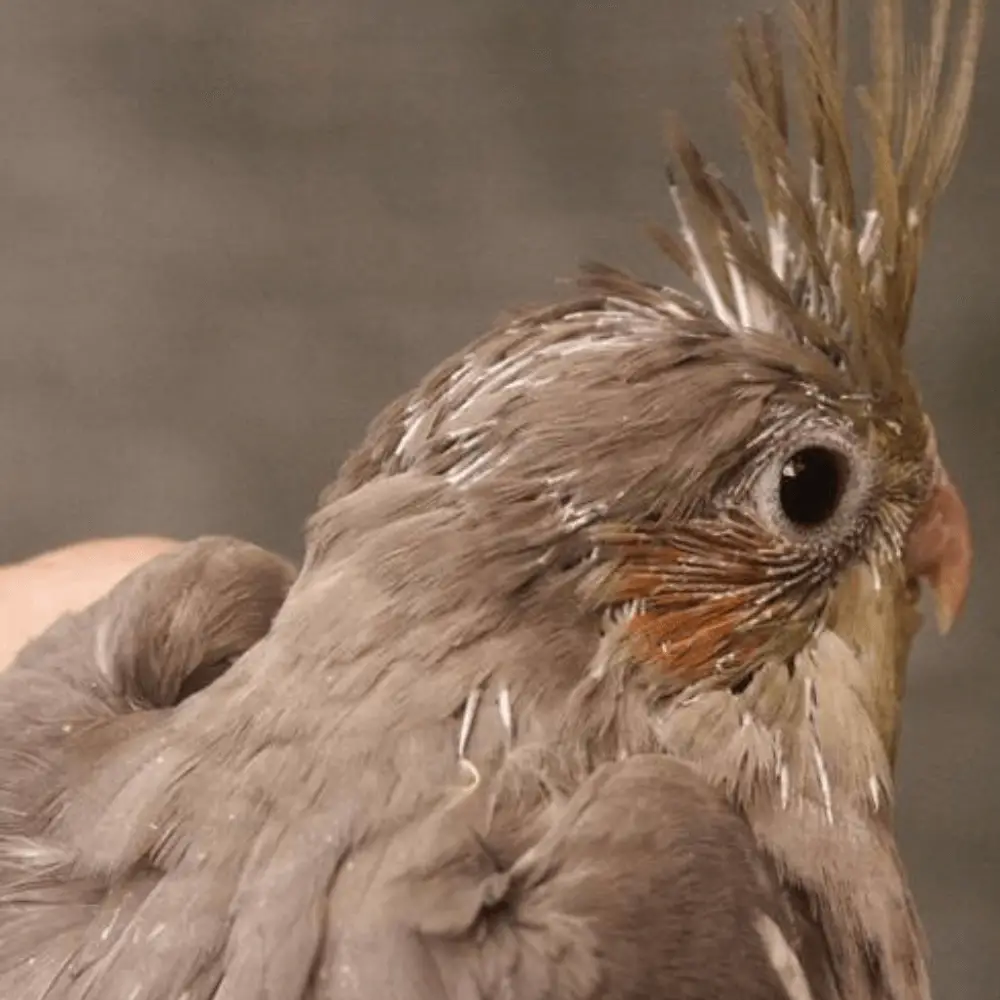
Note the drawing characteristic of the Silver Cockatiel EDGED mutation at the TECTRICES

Note on the young Silver Cockatiel bird at left the color EDGED Type CLAIR excellent, the drawing on the end of the feathers, and the color that remains dark for the head. Excellent bird. The Face-Blanche on the right of the photo is also an EDGED but DARK TYPE

Here is the first EDGED Single Factor PALE FACE GREY high in Europe. Excellent color… and especially this bird was a good breeder from the first year of breeding. It carries some of my hopes to raise the EDGED Double PALE GREY factor
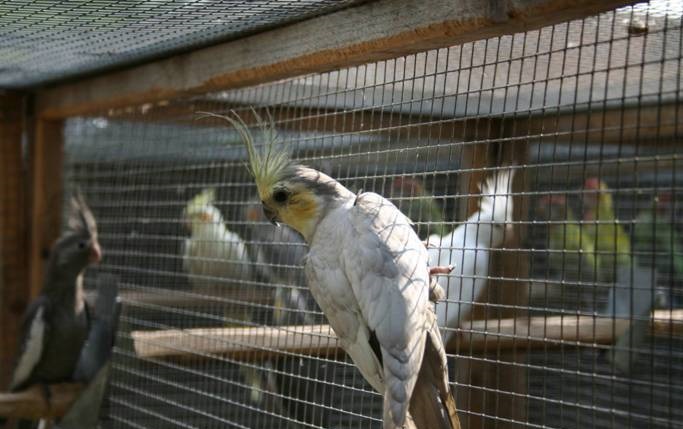
Juvenile subject, Excellent head-body contrast at the nape of the neck. Mutant de Type CLEAR.
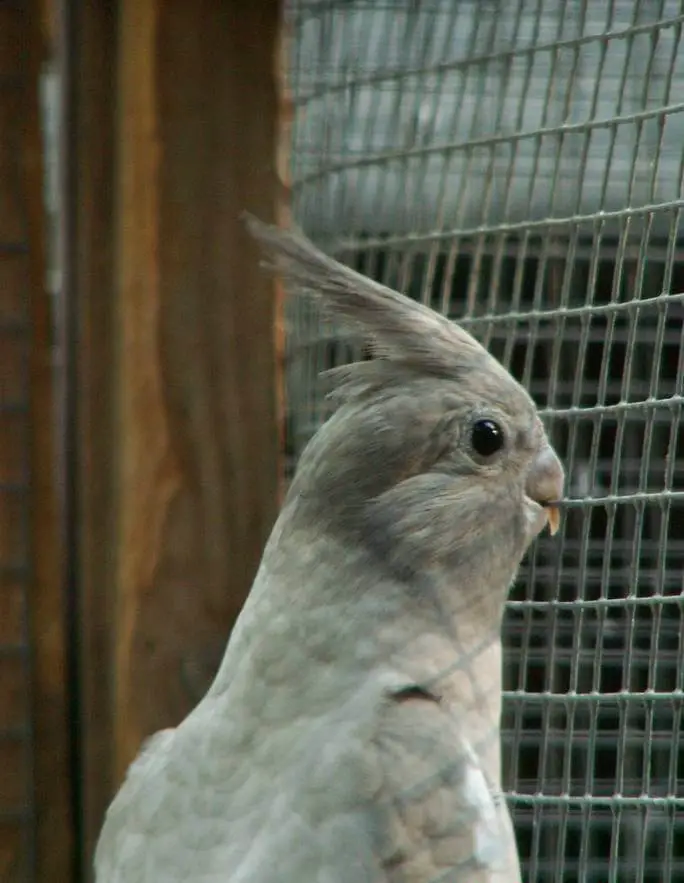
A beautiful brood with parents. Silver Cockatiel EDGED Single Factor GREY-FACE-WHITE (Light TYPE) (the mother) – EDGED Single Factor PALE FACE GREY – EDGED Single Factor PALE FACE GREY (the father) – WHITE FACE GREY – EDGED Double Factor Grey FACE-BLANCHE (note the resemblance at first glance with an albino) – GREY PALE FACE – EDGED Double Factor GRAY FACE-WHITE – EDGED Single Factor GREY-FACE-WHITE”
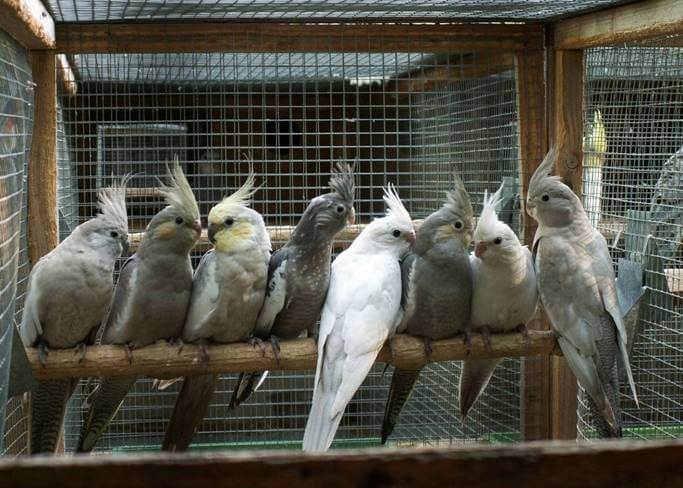
Young GRAY FACE-WHITE, EDGED Single Factor PALE GREY – PALE GREY OPALINE

In this young male EDGED Single Factor GRAY FACE-WHITE we observe very well the contrast between head and body. From this color came the erroneous name BLACKHEAD

Here is the first EDGED Single Factor PALE FACE GREY high in Europe. Excellent color… and especially this bird was a good breeder from the first year of breeding. It carries some of my hopes to raise the EDGED Double PALE GREY factor
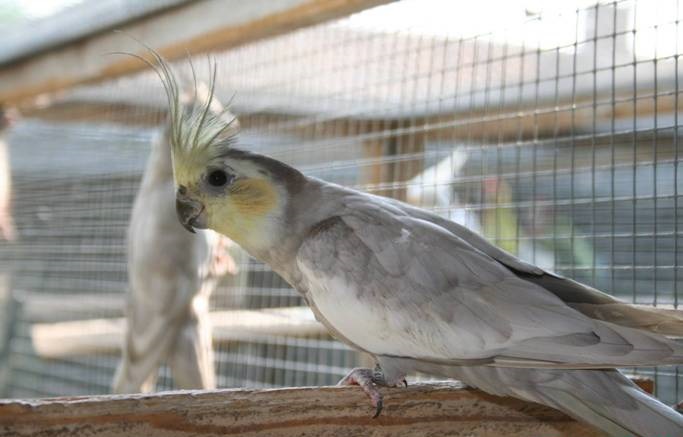
Dominant mutations
Unlike the recessive mutation, the dominant mutation requires just one mutated allele for it to be expressed. That is, a single homozygous mutant parent is enough to obtain young mutants. The sex of the birds does not come into play.
In dominant mutations, dominant genes are present on autosomes and control the visual appearance of the bird. This is referred to as a complete penitential mutation and those with incomplete penance. We also talk about dominant factors, single factors,s and double factors.
However, there is no carrier of a dominant mutation.
There are somewhat peculiar mutations that are called co-dominant: The gene controls a certain percentage of the offspring by being visual in appearance. The phenotype of the bird will be intermediate between that of two homozygous birds. The two alleles of the two birds are expressed simultaneously and their effects add up. This is the case, for example, of white-faced and pale-faced al-lèles.
Example of crossovers
SF = single DF factor = double factor
Grey wild type x dominant single factor
- 50% wild
- 50% dominant SF
Grey wild type x dominant double factor
100% dominant SF
Dominant SF x dominant SF
- 25% wild
- 50% dominant SF
- 25% dominant DF
Dominant SF x dominant DF
- 50% dominant SF
- 50% dominant DF
Dominant DF x dominant DF
100% dominant DF
It is very important to remember:
- On the other hand, there is no homozygous in codominance since it is not at the base of a single mutation but of two mutations that are crossed.
- that there is never a phenomenon of dominance/recessivity between the mutations of a series of multiple alleles but always a codominance between them.
The dominant-edged mutation
All you need to know about cockatiel Dominant silver
Cockatiel dominant silver mutation
The dominant edged mutation in the cockatiel or dominant silver parakeet appeared in 1979 in England. This is the eighth established mutation. It is an autosomal mutation with incomplete dominance (single factor and double factor) and with non-penetrance phenomena.
Non-penetrance explains why we have an edged color that varies from one bird to another. We have clear simple edges but also edges where it is difficult to say that they are edges.
It just takes a single “dominant silver gene” for the mutation to be visible on the bird. It is then said that the bird is edged simple factor. When there are two-edged genes present in a cockatiel, we get a double-factor edged bird. The simple facets have the center of the feathers lighter than the edges.
The color of the head is darker than the body. In Belgium, it is also called black-headed mutation (Zwartmasker or Zwartkop): the gene for the edged mutation dilutes melanin in the center of the feathers except on the feathers of the head. But this is an erroneous name because the mask or head is not black but remains intact while the mutation dilutes the rest of the body which gives a darker mask by contrast.
Difference between single factor and double factor in the cockatiel Edged mutation
Single factor edged (sf) caps have wing covers almost scaled. Melanin is very visible at the level of the tec-trices (the edges of feathers). An edged sf cap is difficult to identify. It resembles a wild type especially when it comes to a dark-type edged sf.
When there is a large amount of melanin on the edges of the feathers, it is called a medium-type sf edged.
Double factors (df) are clearer, and silverier than single factors (sf) and produce even less melanin in the feathers. The plumage as a whole is lighter (dirty white). The head is usually less affected. The combination of the edged mutation with the white face results in an almost albino bird. The only difference is that the edged df fb has black eyes and dark legs. The has streaks under the tail feathers.
A clear-type edged cockatiel has an almost white body and a head that remains black.
Males cockatiel
The plumage of the body is a more or less silvery gray depending on whether it is a single or double factor. The mask is bright yellow. The hoopoe is grey-yellow. The cheeks are a bright orange color. The underside of the rectrices is uniform. The bill and legs are dark. The eyes are black.
Females cockatiel
The female has a plumage of a gray color more or less silvery depending on whether it is a single or double factor. The mask is silvery gray slightly tinged with yellow. The hoopoe is grey-yellow. The cheeks are orange. The des-sous of the caudal feathers is striated. The bill and legs are dark. The eyes are black.
Juveniles
It is difficult to detect edged mutation in juveniles. The edged mutation takes its true color when they are 1 year old, or even 2 years old.
The color of adult cockatiels is progressive and can take 3 to 4 molts to reach the final colo-ration, especially in males. For almost every molt, males cut in color and tend to have lighter coloration. Generally, females do not change coloration much. They can still look like a normal grey mutation and are darker than males.
Crosses and combinations
In the early 2000s, the edged mutation and possible new combinations were the trends of cockatiel breeders. Some combinations, genetically controlled, gave rise to very beautiful colors while other combinations made the identification of the subjects obtained almost difficult.
The clear type edge was initially highly sought after for its beauty. The dark guy didn’t interest anyone at first. But since some breeders realized that double factors worked with dark types and gave better birds, in color, design, and feather quality, significantly better than the dirty whites bred at the beginning. As a result, there has been a renewed interest in dark and medium types. In addition, in competition, the edged must have marked chipping, which is little the case on clear types.
When replicating a double factor (df), it is preferable to couple-edged sf x edged sf. The crossing df x df is to be avoided. It can lead to losses of size and young in the nest. Always mating a double factor to a normal grey (orange cheeks) or a normal white face to achieve the desired size, vigor, and characteristics. There is a wide variety of combinations of edged with other mutations.
The best combinations are in gray series with mutations affecting the color of the cheeks. What to keep in mind is that each edged cap can vary in coloration.
This is why when we want to work on the edged mutation, we must take into consideration the single factor subjects and the double factors and take into account their defects and the improvement observed in the double factors that makes it possible to eliminate the subjects too clear.
The cockatiel-edged and cinnamon combination
The cinnamon gene can mask the distinctive features of the edged mutation and result in a bird that will visually resemble a cinnamon. The head is normal for a body that pulls on bronze fallow.
The cockatiel-edged combination with the ADM cooler
The variegated will mask many identifiable features, such as the removal of the skull cap, and affect the som-bre edges and diluted centers of the wings. This combination tends to give birds little contrast and especially to invade the stumps with white-naped (WN).
The cockatiel combination of edged with opaline
This cross gives a bird that resembles a nor-male opaline or cinnamon, especially the edged females.
The combination with lutino
The lutino gene masks the edged mutation. Ino edges have light melanin markings on feathers, tectrices, and tails.
It will take several more years to homogenize the strains of edged caps. But the work is already well advanced among some breeders who control the combinations well and look for vigorous and good-sized birds.
Edged sf white face Edged cinnamon –Photos by Thierry Dulière
Edged sf opaline – Photos by Hafid Hanfaoui
Edged single-factor cinnamon
Edged Sf pale face Photos by Thierry Dulière
Edged Df pale face
Edged sf Medium type Pale face Edged Df Dark type Light face –Photos by Thierry Dulière
This article is from the book “The secrets of the parakeet cockatiel” by Hafid Hanfaoui available for reservation by clicking on the link below
Related Articles:
- Hand feeding cockatiel
- How to set up a cockatiel cage
- Cockatiel diarrhea
- Cockatoo vs cockatiel
- Difference between cockatoo and cockatiel
- Adopting a cockatiel all you need to know
- Cockatiel origin and physiology
- Cockatiel emergencies
- Cockatiel lesions injuries and masses
- Cockatiel treatment and preventive care
- Cockatiel pecking
- Cockatiel behavior
- Cockatiel anatomy
- Cockatiel bites




















